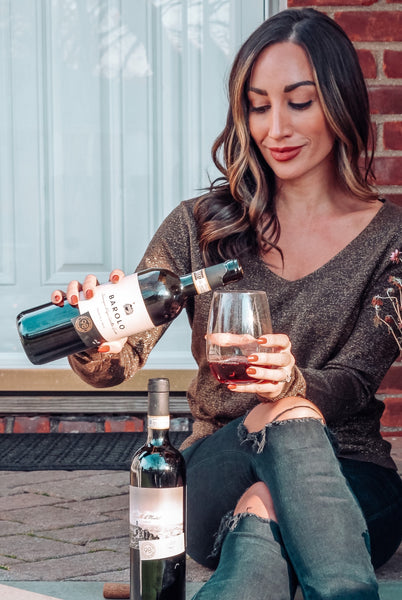Special occasions call for special wines. That's why we're exploring Italy's two great wines as we head into the holiday season. Wine scholar and blogger, Nicole Muscari (a.k.a. @grapechic on Instagram), gives us the grape guide on Barolo and Brunello di Montalcino in this "Beyond the Glass" guest blog series. So pour yourself a glass, and let's head to Italy!
If you have an affinity for Italian wine like me, you’re probably familiar with Barolo and Brunello di Montalcino. Out of all the designated areas of wine production in Italy, Barolo and Montalcino could be considered some of the most prestigious. Although these wines are amongst the most sought-after in Italy, they are quite different in both style and flavor profile. These differences are due to several factors including climate, grape variety, and winemaking. Let’s take a sip trip to these two regions and discover what makes them so unique!
Barolo
We’ll start in northern Italy in the region of Piemonte. Piemonte has a moderate continental climate which means there is a noticeable difference between the summer and winter months. There are mountains to the north of the region which provide protection from precipitation, and there are two bodies of water that help regulate temperatures which include the Po River to the south and Lake Maggiore to the north. This is extremely important as winters can be quite long and cold, and summers are subjected to hail and thunderstorms.
Within Piemonte is where you’ll find the designated wine region of Barolo DOCG. Barolo is a horseshoe-shaped valley with steep, south-facing slopes. These slopes provide excellent drainage, while the southern exposure helps to ensure the grapes will ripen properly. We also can’t forget elevation does play a role in the north. In Barolo, you can expect to find vines planted between 300-500 meters above sea level. Elevation ensures a larger diurnal shift in temperatures between day and night allowing the grapes to ripen slowly. This “slow and steady” ripening process attributes to the aromatic intensity you commonly find in this region.
Let’s get to the “King" grape of the region…Nebbiolo. Nebbiolo is a thin-skinned red grape that gives wines that are light in color, with high tannins and high acidity. Common characteristics include tart cherry, roses, leather, and herbs. Under DOCG regulations, Barolo must be aged a total of three years before it is released and 18 months of which must be in oak barrel. This incredible structure allows these wines to age for a very long time!
90+ Cellars Lot 26 Barolo is an excellent example of what this region has to offer. Upon the first swirl, this wine is bursting with red cherry, smoke, dried herbs, warm baking spices like cinnamon and nutmeg, and fresh pink flowers. The body is medium with mouth-watering acidity and supple tannins. The finish is long, and I immediately want to pair this wine with white truffle risotto and porcini mushrooms.
Brunello di Montalcino
Now we’ll head south to the sun-drenched region of Tuscany where we’ll find our next wine. Tuscany itself is broken up into three parts - there is Chianti in the northern part of the region, some valleys and hills to the south, and the flat coastal plain to the west. We’ll be focusing our attention south where we’ll find Brunello di Montalcino DOCG.
Brunello di Montalcino DOCG is lower in elevation and noticeably warmer than the other parts of Tuscany. Grapes can find some relief from ocean breezes sweeping in from the west which helps them to retain acidity. Unlike Barolo, the vineyards here are planted on a large range of different slopes and aspects. This also contributes to the sheer beauty of those rolling Tuscan hills! Sangiovese is going to be our star grape variety of Brunello di Montalcino (and all of Tuscany for that matter).
Sangiovese is late-ripening, with high levels of tannin and acidity. Flavors and aromas typically include tart cherry, red plum, potpourri, dried herbs, tomato, and leather. In Brunello di Montalcino, the wines must be 100% Sangiovese and age a minimum of 5 years (2 must be in oak). Because of this, these wines are often more robust in body with added texture and oak characteristics like warm baking spices and smoke. Being a bit warm here in the southern part of the region, the fruit characteristics can become quite ripe or dried and can even include some black fruit tones.
90+ Cellars Lot 203 Brunello di Montalcino tastes like my memory of a Tuscan sunset. There is a moment of warmth, yet it’s incredibly fresh. There is an abundance of dried red cherry, blackberry, violet, dried herbs like thyme and oregano, cigar box, and sweet spice. This wine is incredibly layered with high acidity and fine tannins. It’s a wine that should lay down a bit to show its full potential, although it’s already a delicious addition to the dinner table. I’ll have the Bistecca alla Fiorentina please!
Sipping Barolo and Brunello di Montalcino is truly a memorable experience. These wines will stand the test of time and are an incredible addition to any wine lover’s cellar. Whether you’re “team Barolo,” or “team Brunello”…me too.
Cheers!
Nicole Muscari



